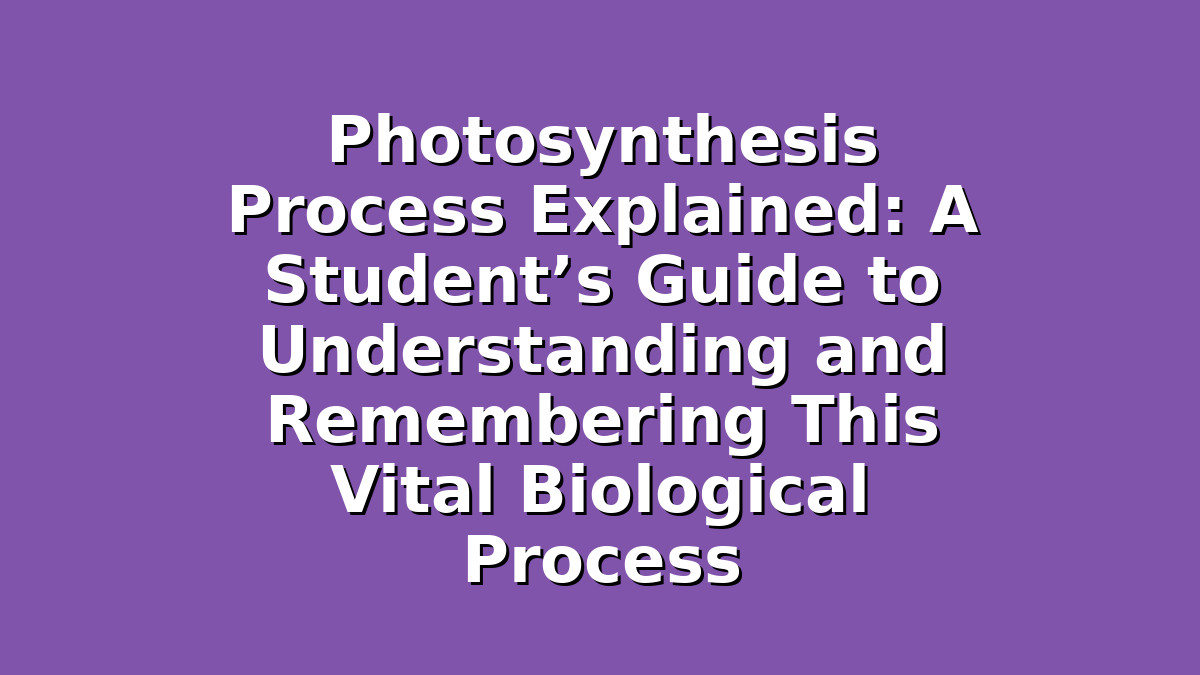If you’re a student preparing for biology exams, understanding photosynthesis is essential. This process is fundamental to life on Earth, often a key topic in school curricula, and can sometimes feel complex with all its scientific terms and stages. Don’t worry—this guide will explain the photosynthesis process clearly and offer practical study tips to help you master the material confidently and efficiently.
What Is Photosynthesis and Why Is It Important?
Photosynthesis is the process by which green plants, algae, and some bacteria convert sunlight into chemical energy. Using carbon dioxide from the air and water from the soil, these organisms produce glucose (a type of sugar) and oxygen. This process fuels plant growth and provides energy to nearly all living organisms on the planet, either directly or indirectly.
For students, grasping photosynthesis is not just about memorizing steps; it’s about understanding how life sustains itself. From oxygen production that we breathe to the food chains that feed animals and humans, photosynthesis plays a crucial role.
Section 1: Understanding the Photosynthesis Process Step-by-Step
To ace your exams, break down photosynthesis into manageable parts:
1. The Basic Chemical Equation
Photosynthesis can be summarized as:
6CO₂ + 6H₂O + light energy → C₆H₁₂O₆ + 6O₂
This means six molecules of carbon dioxide and six molecules of water, using light energy, create one glucose molecule and six oxygen molecules.
2. The Two Main Stages
Photosynthesis occurs in two primary stages: the Light-Dependent Reactions and the Light-Independent Reactions (Calvin Cycle).
– Light-Dependent Reactions:
These take place in the thylakoid membranes of chloroplasts. Chlorophyll pigments absorb sunlight, which energizes electrons. The energy splits water molecules into oxygen, protons, and electrons. Oxygen is released as a by-product. Additionally, ATP and NADPH are produced—energy carriers used in the next stage.
– Light-Independent Reactions (Calvin Cycle):
Occurs in the stroma of chloroplasts, where ATP and NADPH from the light reactions power the conversion of carbon dioxide into glucose. This cycle involves carbon fixation, reduction, and regeneration of the molecules that capture CO₂.
3. Key Terms to Remember:
– Chlorophyll: The green pigment that absorbs light.
– Chloroplast: The organelle where photosynthesis happens.
– ATP and NADPH: Energy storage molecules generated in light reactions.
– Glucose: The sugar produced, used as energy for growth.
Study Tip: Use Diagrams and Flashcards
Visual aids are your best friends. Draw or find labeled diagrams of chloroplasts showing where each stage happens. Create flashcards with key terms and definitions. Reviewing these regularly helps reinforce concepts and makes it easier to recall details during exams.
Section 2: Connecting Photosynthesis to Real-Life Examples
Understanding theory is important, but connecting photosynthesis to everyday life can make the material more interesting and memorable.
1. Photosynthesis and Food Chains
Plants produce glucose via photosynthesis, which they use to grow. Animals that eat plants obtain energy from this glucose. When you eat fruits, vegetables, or grains, you are consuming the energy initially captured from sunlight.
2. Oxygen Production and Breathing
The oxygen released during photosynthesis is what most organisms, including humans, need to breathe. Recognizing this connection highlights the process’s importance beyond plants themselves.
3. Environmental Impact
Photosynthesis helps reduce carbon dioxide in the atmosphere, playing a big role in regulating Earth’s climate. Trees and plants act as carbon sinks, which is why planting trees is a great environmental initiative.
Study Tip: Relate Concepts to Your Own Life
Think about the plants around your home or school. Consider how they help keep air clean and provide food. Making these personal connections can improve your understanding and make your study sessions feel more meaningful.
Section 3: Effective Study Techniques for Mastering Photosynthesis
Now that you understand the process and its significance, here are strategies to help you study this topic efficiently:
1. Teach Someone Else
Explaining photosynthesis to a friend, family member, or even to yourself out loud can solidify your knowledge. Teaching forces you to organize your thoughts clearly and identify areas where you need more practice.
2. Practice Past Exam Questions
Look for exam papers or quizzes that test photosynthesis. Practice answering questions under timed conditions. This not only tests your knowledge but also builds exam confidence.
3. Use Mnemonics and Analogies
Create memory aids to remember the sequence of stages or components. For example, to remember the outputs of photosynthesis (Glucose and Oxygen), you might think: “Good Oxygen” or create a phrase using the first letters of key terms.
4. Break Study Sessions into Chunks
Avoid cramming. Study photosynthesis in short, focused sessions over several days. This spaced repetition improves long-term retention.
Study Tip: Combine Multiple Learning Styles
Use a mix of reading, writing notes, drawing diagrams, and listening to educational videos. This multi-sensory approach caters to different learning preferences and helps you understand and remember complex topics better.
Conclusion
Photosynthesis is a fascinating and vital biological process that every student should understand well, especially when preparing for exams. By breaking down the process into clear stages, connecting it to real-life examples, and using effective study techniques like teaching, practicing past questions, and employing mnemonics, you can conquer this topic with confidence.
Remember, consistent effort and a positive mindset are key. Photosynthesis might seem complex at first, but with the right approach, it becomes an understandable and even enjoyable subject. Keep practicing, stay curious, and good luck with your studies!

Responses